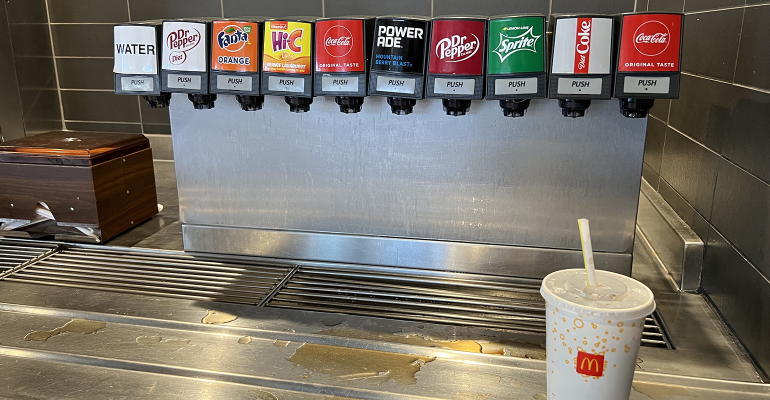You may have heard the news that McDonald’s is planning to phase out its self-serve beverage stations by 2032, so now the question now becomes “why?”
Simply put, the transition is being made to allow for more consistency as customers order through more channels, as was first reported by The State Journal-Register. The publication quoted Illinois operator Mikel Petro as saying, “It’s an evolution towards convenience and the growth of digital service.” The restaurants that have begun phasing out the machines are relying on staff to prefill drinks and deliver them to customers at their tables, creating a more hospitable environment, the publication reports. Employees are also pre-filling drinks for digital orders.
In a statement, the company said, “McDonald’s will be transitioning away from self-serve beverage stations in dining rooms across the U.S. by 2032. The change is intended to create a consistent experience for both customers and crew across all ordering points, whether that’s McDelivery, the app, kiosk, drive-thru or in-restaurant.”
This makes sense on paper given that McDonald’s digital sales now represent nearly 40% of systemwide sales in its top markets, including in the U.S. Delivery is a big part of that number and continues to grow. The company is breaking down its organizational silos to pull best practices from its various markets and that includes keeping an eye on China and its 90% digital sales mix. Could the company get to that number in the U.S., as well? Swiftly changing demographics could feasibly facilitate this mix eventually (maybe even by 2032) and would no doubt render such a maintenance-heavy self-service machine moot.
As the shift to digital continues to accelerate, McDonald’s – like many of its peers – has started experimenting with new formats with smaller dining rooms, or no dining rooms at all. We’re on the ground floor of this format trend, which will likely continue to accelerate alongside the growth of digitally-driven and off-premises channels, including the drive-thru.
It’s worth noting that while this “news” is new, it’s more iterative. During the throes of the pandemic, McDonald’s closed off its beverage stations, and some restaurants got rid of them all together. It wasn’t the only concept to do so, either.
Of course, as we learned more about the transmission of Covid-19, more started “reopening” those stations, but as dining rooms simultaneously became less crowded, their presence became less necessary. Their presence also became less efficient given the ongoing maintenance, cleaning and labor required for their upkeep (labor that wasn’t necessarily readily available the past few years). As such, operators interviewed by the State Journal-Register cited food safety protocols as another reason for the phase-out. Theft prevention is also listed, as customers occasionally swap their water orders for a Sprite. In an environment with relentlessly pressured profit margins, every dime counts.
That said, could there be a downside to this? Certainly, and especially among heavy dining room users such as families with children and customers who have grown used to having control over this component of their dine-in experience. Or, perhaps among some franchisees who experience high dining room traffic, such as in suburban/rural markets. What about those franchisees who have already completed their remodels with self-service beverage stations, how does this impact them?
McDonald’s complete removal of self-serve drinks won’t be complete for another nine years, so there is plenty of time to work out any pain points. What we know now is they’re increasingly harder to justify as consumers increasingly access the brand from everywhere but the dining room.
Contact Alicia Kelso at [email protected]

